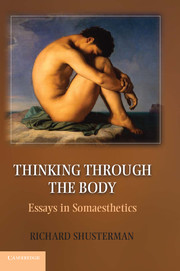Book contents
- Frontmatter
- Contents
- Preface
- Introduction
- Part I Somatic Being, Knowing, and Teaching
- Part II Somaesthetics, Aesthetics, and Culture
- 6 Somaesthetics and the Limits of Aesthetics
- 7 Somaesthetics and Burke's Sublime
- 8 Pragmatism and Cultural Politics
- 9 Body Consciousness and Performance
- Part III The Arts and the Art of Living
- Select Bibliography
- Index
- References
9 - Body Consciousness and Performance
Somaesthetics East and West
Published online by Cambridge University Press: 05 November 2012
- Frontmatter
- Contents
- Preface
- Introduction
- Part I Somatic Being, Knowing, and Teaching
- Part II Somaesthetics, Aesthetics, and Culture
- 6 Somaesthetics and the Limits of Aesthetics
- 7 Somaesthetics and Burke's Sublime
- 8 Pragmatism and Cultural Politics
- 9 Body Consciousness and Performance
- Part III The Arts and the Art of Living
- Select Bibliography
- Index
- References
Summary
I
Embodiment is a universal feature of human life, and so is body consciousness. Body consciousness, as I understand it, is not merely the consciousness that a mind may have of the body as an object, but includes the embodied consciousness that a living sentient body directs at the world and also experiences in itself (and through which it indeed can experience itself as both subject and object). Enhancing one's body consciousness to achieve better self-awareness and self-use is central to the project of somaesthetics and helpful in promoting philosophy's traditional goals of knowledge, self-knowledge, virtue, happiness, and justice.
Consciousness has different levels. At its most basic form of primitive body intentionality, we can even describe a level of what could paradoxically be called unconscious consciousness. This is the sort of limited, obscure awareness we exhibit in our sleep, when, for example, we intentionally (though unconsciously) move a pillow that is disturbing our breathing. Beyond this level is the stage when we are awake and clearly conscious of the object we perceive, say the cup of coffee we are holding and drinking from, but are not explicitly aware of it as a distinct object of consciousness, as when we are drinking the coffee absentmindedly or simply noticing the coffee's taste and not the cup. Yet, even without explicit awareness, we can handle the cup with efficiency and ease. This level of unreflective, unthematized perception is what Merleau-Ponty hails as “primary consciousness” and the fundamental, unappreciated key to the mystery of our successful perception and action. We reach a higher level of consciousness when we have explicit awareness of the cup, when we attend to it as a distinct object of consciousness; and we can distinguish a fourth, more reflective, level when we are not only explicitly conscious of the object but also conscious of how (and that) we are conscious of it. Here we consciously monitor our awareness of the object as an explicit datum of consciousness; noticing, for example, how our attention to the cup makes it look bigger or feel heavier.
- Type
- Chapter
- Information
- Thinking through the BodyEssays in Somaesthetics, pp. 197 - 216Publisher: Cambridge University PressPrint publication year: 2012



